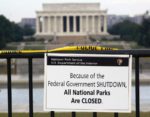 When hearing the periodic updates, the places most Americans would assume to be the most affluent in America would be Beverly Hills, Silicon Valley, the Upper East Side, not to mention the “nice” parts of most major metropolitan areas. But when those numbers come out, there is little fanfare of these statistics because it would again illustrate the ongoing disparity between those who are forced to pay taxes and those who live quite comfortably off them.
When hearing the periodic updates, the places most Americans would assume to be the most affluent in America would be Beverly Hills, Silicon Valley, the Upper East Side, not to mention the “nice” parts of most major metropolitan areas. But when those numbers come out, there is little fanfare of these statistics because it would again illustrate the ongoing disparity between those who are forced to pay taxes and those who live quite comfortably off them.
In this particular case, simple numbers explain why things don’t get done in an efficient manner in our nation’s capital.
Americans’ incomes have risen in recent years, but the wealth hasn’t been evenly distributed, according to the latest estimates from the U.S. Census Bureau. There were 21 counties with median household incomes above $100,000, the new estimates show, and half of the top 10 fell in northern Virginia, just outside the nation’s capital, which itself boasted a median income of $77,649.
— US News & World Report, 12/6/19
 The Washington D.C. region including The District, Southern Maryland and Northern Virginia is unsympathetically referred to as “recession proof” because when cyclical economic downturns befall the rest of the nation, certain people are almost always spared the pain.
The Washington D.C. region including The District, Southern Maryland and Northern Virginia is unsympathetically referred to as “recession proof” because when cyclical economic downturns befall the rest of the nation, certain people are almost always spared the pain.
The Great Recession is one of the most severe economic downturns in American history. Washington D.C. appeared almost unscathed as the rest of the country suffered. The capital city was also one of the first places to start seeing growth when the recovery started. Washington’s success stirred resentment as the region thrived amidst the downturn. New buildings and a wealthy economy were fueled by the federal government and taxpayers.
— Inside Sources, 8/7/17
One would think those fortunate enough to be gainfully employed with generous compensation and benefits would be grateful to those who pay to maintain those comfortable lifestyles.
Alas, that is not always the case….
…
Unlike most industries that actually create and manufacture products that people are willing to purchase, D.C. creates virtually nothing aside from constant reasons why they should keep their jobs, if not create more for those with mediocre creativity and incentive to improve their skills.
 One possible reason there is so much resistance to the Trump presidency is that the president’s business acumen has exposed a culture where the actual completion of a project puts fat-and-happy incomes in peril. After a building is erected, those who built it move on and look for another construction project. In D.C., simple tasks are oh-so slowly performed as to not put their jobs in peril and that philosophy trickles down to the lackluster approach of foreign policy, health care, or mostly anything that could improve the lives of citizens by making a solvable problem go away.
One possible reason there is so much resistance to the Trump presidency is that the president’s business acumen has exposed a culture where the actual completion of a project puts fat-and-happy incomes in peril. After a building is erected, those who built it move on and look for another construction project. In D.C., simple tasks are oh-so slowly performed as to not put their jobs in peril and that philosophy trickles down to the lackluster approach of foreign policy, health care, or mostly anything that could improve the lives of citizens by making a solvable problem go away.
The cost of living is also much higher in this area because higher-paid federal employees have more disposable income and those who service them took note many, many years ago.
 One thing that drives the capital and its environs is those very large federal paychecks, which now amount to about $90,000 a year in money wages and just under $125,000 a year in total compensation. Washington pay has long been above the national average, but it is pulling away. In 2000, the median compensation for an American worker at large was about 74 percent of the median compensation for a federal employee; today, the average working taxpayer makes only 55 percent of what the average federal tax-eater makes. Our would-be class warriors talk about “transfers of wealth” and “transfers of income” when they mean mere changes in those metrics, but in this case, there is a literal transfer, with the most fearsome agency of the federal government — our corrupt and politicized IRS — raiding our households and businesses to support $1,000-a-night La Tur habits in Washington.
One thing that drives the capital and its environs is those very large federal paychecks, which now amount to about $90,000 a year in money wages and just under $125,000 a year in total compensation. Washington pay has long been above the national average, but it is pulling away. In 2000, the median compensation for an American worker at large was about 74 percent of the median compensation for a federal employee; today, the average working taxpayer makes only 55 percent of what the average federal tax-eater makes. Our would-be class warriors talk about “transfers of wealth” and “transfers of income” when they mean mere changes in those metrics, but in this case, there is a literal transfer, with the most fearsome agency of the federal government — our corrupt and politicized IRS — raiding our households and businesses to support $1,000-a-night La Tur habits in Washington.
— National Review, 11/6/16
This has also had the negative effect of gentrification which, despite the faux laments, makes these areas whiter, more “progressive” thus less tolerant of those not well paid, liberal and white.
The mediocrity, when it comes to the calibre of the typical federal employee, is also a self-maintaining mechanism because they are in the majority. Federal employee unions have made it almost impossible to shed dead weight and generous pensions are one of the sole motivators of those who’ll do just enough to do their “25” so taxpayers can enjoy the privilege of supporting them for the rest of their lives.
 And that is why you see Hill staffers who put in ten years at modestly-paid jobs and then go to work at lobby shops that pay them enough to drive a Bentley and live in one of those horrifying weird $3 million suburban piles in Arlington.
And that is why you see Hill staffers who put in ten years at modestly-paid jobs and then go to work at lobby shops that pay them enough to drive a Bentley and live in one of those horrifying weird $3 million suburban piles in Arlington.
The nonprofit sector (representing many ideologies and causes) also thrives where principles are sanctimoniously packaged; principals are lavishly compensated while they suck up to those in the immediate area who enjoy annual tax write offs. Their overheads are many times more than those in private sector, and they really don’t have to achieve their promoted missions. The media is hardly any better as so many employees never leave their office spaces to collect news, but simply search online for interesting stories they can repackage (aggregate) and make their own.
 Whenever the gloom-and-doom of a government shutdown reaches public awareness, it’s been shown many Americans are fairly indifferent because they’re rarely inconvenienced. But it the D.C. area, it’s time to panic. The media throws government employee sob stories in our faces. We’re to feel sorry for those who’ll suddenly find themselves out of work while most everyone knows as soon as the shutdown ends, these employees will be back to work and receive compensation for the forced time off.
Whenever the gloom-and-doom of a government shutdown reaches public awareness, it’s been shown many Americans are fairly indifferent because they’re rarely inconvenienced. But it the D.C. area, it’s time to panic. The media throws government employee sob stories in our faces. We’re to feel sorry for those who’ll suddenly find themselves out of work while most everyone knows as soon as the shutdown ends, these employees will be back to work and receive compensation for the forced time off.
But the most ironic is how the media mismanages optics by presenting federal employees, most of whom one would think is primarily worried about how to pay rent or a mortgage, daycare costs, make car payments, etc.
One in five new vehicles sold in those states is from a luxury marque (about a third higher than the national average) with BMW leading the way, because D.C. is exactly that douchey, and Mercedes-Benz in second place. Aston-Martin is unusually popular in Virginia; Bentley sells unusually well in Maryland.
 It turns out most important to these employees is food, which bad optics is manifest when you see the obese whining on broadcast news, alerts are issued by local supermarkets and restaurants that a federal government identification card entitles them to free meals, goodie bags and breaks on bills because we should all sympathize with them; a concept not bestowed on Americans when politically-bollixed bad times hit the rest of the nation.
It turns out most important to these employees is food, which bad optics is manifest when you see the obese whining on broadcast news, alerts are issued by local supermarkets and restaurants that a federal government identification card entitles them to free meals, goodie bags and breaks on bills because we should all sympathize with them; a concept not bestowed on Americans when politically-bollixed bad times hit the rest of the nation.
Restaurants are offering free food for workers who present their government IDs, historic sites are offering passes to federal workers, major banks are rolling out special assistance programs, and some centers are even offering free knitting classes for government employees.
— The Hill, 1/3/19
So, pay attention whenever census numbers again reveal the have-and-have-nots are not just a rich vs. the poor political narrative. It’s also a reminder that there are hundreds of thousands of people in one relatively small region of the United States that are living a comfortable life and despite what they’re not doing or doing TO us, expect us to maintain them.


[…] of the nation’s wealthiest counties surround Washington, D.C. and the vast majority of federal employees donate and vote Democrat. In […]
[…] federal employees, with incomes two or three times the national median, potentially imperiling a very comfortable lifestyle, generous potential pension and benefits, respectable mortgage payments in gentrified […]
[…] federal employees, with incomes two or three times the national median, potentially imperiling a very comfortable lifestyle, generous potential pension and benefits, respectable mortgage payments in gentrified […]